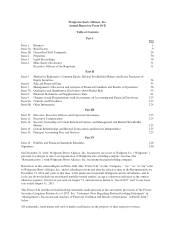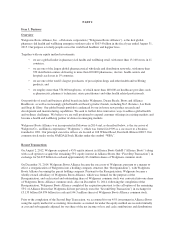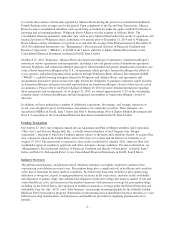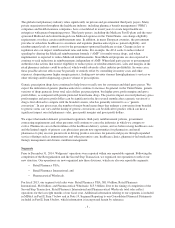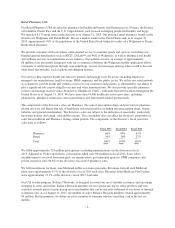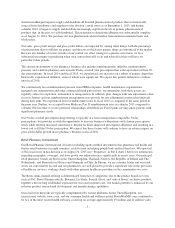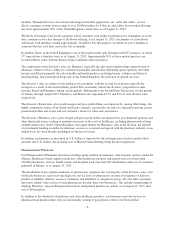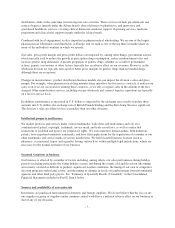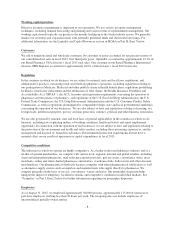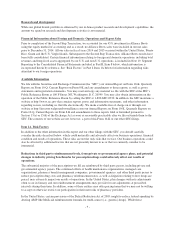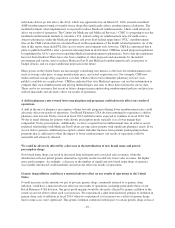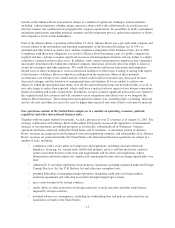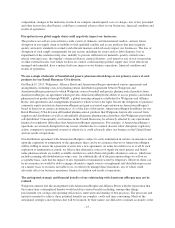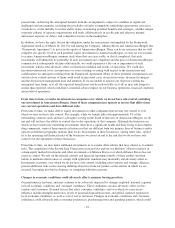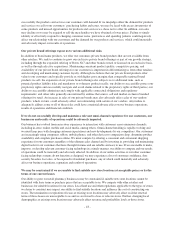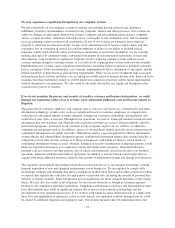Walgreens 2015 Annual Report Download - page 14
Download and view the complete annual report
Please find page 14 of the 2015 Walgreens annual report below. You can navigate through the pages in the report by either clicking on the pages listed below, or by using the keyword search tool below to find specific information within the annual report.reductions did not go into effect, the ACA, which was signed into law on March 23, 2010, enacted a modified
AMP reimbursement formula for multi-source drugs that significantly affects reimbursement calculations. The
modified formula, when implemented, is expected to reduce Medicaid reimbursements, which could adversely
affect our results of operations. The Centers for Medicare and Medicaid Services (“CMS”) is preparing to use the
modified reimbursement formula to calculate a U.S. federal ceiling on reimbursement rates for multi-source
drugs to pharmacies under the Medicaid program, and posts draft federal upper limit (“FUL”) reimbursement
files on the CMS website that are calculated based on the requirements of the health reform legislation. As of the
date of this report, these draft FUL files are for review and comment only; however, CMS has announced that it
plans to publish final FULs after a period of releasing them in draft format. CMS has issued proposed regulations
to implement the ACA’s provisions regarding Medicaid reimbursement to pharmacies, but to date the regulations
have not been finalized. There have also been a number of other proposals and enactments by the federal
government and various states to reduce Medicare Part D and Medicaid reimbursement levels in response to
budget deficits, and we expect additional proposals in the future.
Many payers in the United States are increasingly considering new metrics as the basis for reimbursement rates,
such as average sales price, average manufacturer price, and actual acquisition cost. For example, CMS now
makes national average drug acquisition cost data, which reflect retail community pharmacy invoice costs,
publicly available on a regular basis. CMS has indicated that state Medicaid agencies can use this information to
compare their own reimbursement and pricing methodologies and rates to those derived from the survey data.
There can be no assurance that recent or future changes in prescription drug reimbursement policies and practices
will not materially and adversely affect our results of operations.
A shift in pharmacy mix toward lower margin plans and programs could adversely affect our results of
operations.
A shift in the mix of pharmacy prescription volume towards programs offering lower reimbursement rates could
adversely affect our results of operations. Our Retail Pharmacy USA division continued to experience a shift in
pharmacy mix towards 90-day at retail in fiscal 2015 and that trend is expected to continue in fiscal 2016. Our
90-day at retail offering for patients with chronic prescription needs typically is at a lower margin than
comparable 30-day prescriptions. Additionally, we have accepted lower reimbursement rates in order to secure
preferred relationships with Medicare Part D plans serving senior patients with significant pharmacy needs. If we
are not able to generate additional prescription volume and other business from patients participating in these
programs that is sufficient to offset the impact of lower reimbursement, our results of operations could be
materially and adversely affected.
We could be adversely affected by a decrease in the introduction of new brand name and generic
prescription drugs.
New brand name drugs can result in increased drug utilization and associated sales revenues, while the
introduction of lower priced generic alternatives typically results in relatively lower sales revenues, but higher
gross profit margins. Accordingly, a decrease in the number of significant new brand name drugs or generics
successfully introduced could materially and adversely affect our results of operations.
Generic drug inflation could have a material adverse effect on our results of operations in the United
States.
Overall increases in the amounts we pay to procure generic drugs, commonly referred to as generic drug
inflation, could have a material adverse effect on our results of operations, including particularly those of our
Retail Pharmacy USA division. Our gross profit margins would be adversely affected by generic inflation to the
extent we are not able to offset such cost increases. We experienced a shift from historical patterns of deflation in
generic drug costs to inflation in fiscal 2014, when we experienced cost increases on a subset of generic drugs
that in some cases were significant. This generic inflation continued with respect to certain generic drugs in fiscal
-10-


